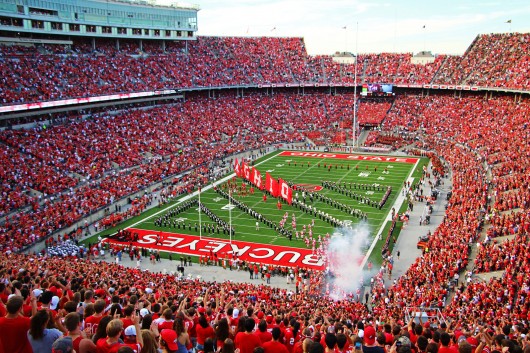
A view from the Ohio Stadium stands before a game against Cincinnati on Sept. 27. OSU won, 50-28.
Credit: Mark Batke / Photo editor
To many at Ohio State, the college football season is one of the most highly-anticipated times of the year. More than 100,000 students, alumni and fans across the state fill Ohio Stadium on gameday to watch and support their Buckeyes, regardless of who the opponent is that day.
However, what most people don’t think about while caught up in the electric atmosphere produced by college football is the business aspect of things. At the end of the day, after all, college football is a business. It is a business that generates millions upon millions of dollars each year for top programs across the country.
Millions of dollars that — at least partially — should go back to the student athletes.
An article recently published by The Lantern said each OSU home game reaps a total revenue of about $7.15 million. After paying the visiting team and other gameday expenses, the net income for a gameday at OSU is about $5.75 million.
While those numbers didn’t quite shock me, I was forced to put them in perspective. After doing some simple math, I estimated the athletic department should make a profit of more than $40 million off of the seven home games this season. And that number doesn’t even factor in premium ticket prices for games against Virginia Tech and Michigan.
Of course, OSU isn’t the only university that sees money coming in on fall Saturdays. The University of Alabama’s athletic program has been known to generate more revenue than any team in the NHL and a majority of the teams in the NBA. Back in my home state, the University of Texas’ football program alone produced more than $100 million in revenue for two straight years. The Longhorns remain the only college football program in history to reach the $100 million mark.
Seeing these numbers stirs up the old and controversial question of whether major program universities should pay their athletes for their part in earning this money. While playing a marquee sport like football or basketball at a Division I school should be considered a privilege, the student-athletes are clearly under-compensated based off the profits earned each year.
Without the hard work of student-athletes, especially football players, the business model of college athletics would fall apart. In any good business, customer satisfaction should be the top priority. The quality of the product, in this case being the football team, should meet the standards expected by the fan base. If not, fans might not come out in droves to sell out stadiums, causing ticket sales to drop. With all due respect to the coaching staff, fans know that it’s the players themselves who make or break a team.
It would make sense for student-athletes who participate in such high-revenue sports to not be kept out of the loop. Not to say that student-athletes should be given salaries like professionals, but they deserve more than what they’re currently getting from their respective universities.


